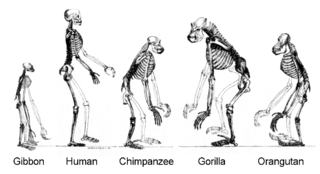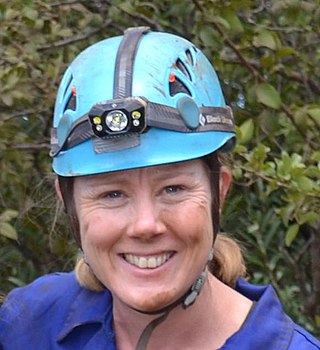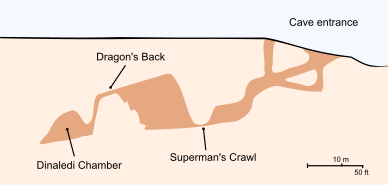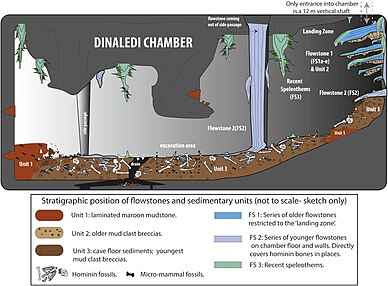
Human evolution is the evolutionary process within the history of primates that led to the emergence of Homo sapiens as a distinct species of the hominid family, which includes all the great apes. This process involved the gradual development of traits such as human bipedalism, dexterity and complex language, as well as interbreeding with other hominins, indicating that human evolution was not linear but weblike. The study of the origins of humans, also called anthropogeny, anthropogenesis, or anthropogony, involves several scientific disciplines, including physical and evolutionary anthropology, paleontology, and genetics.

Homo is the genus that emerged from the genus Australopithecus and encompasses the extant species Homo sapiens and several extinct species classified as either ancestral to or closely related to modern humans, including Homo erectus and Homo neanderthalensis. The oldest member of the genus is Homo habilis, with records of just over 2 million years ago. Homo, together with the genus Paranthropus, is probably sister to Australopithecus africanus, which itself had split from the lineage of Pan, the chimpanzees.
Paleoanthropology or paleo-anthropology is a branch of paleontology and anthropology which seeks to understand the early development of anatomically modern humans, a process known as hominization, through the reconstruction of evolutionary kinship lines within the family Hominidae, working from biological evidence and cultural evidence.

The Cradle of Humankind is a paleoanthropological site and is located about 50 km (31 mi) northwest of Johannesburg, South Africa, in the Gauteng province. Declared a World Heritage Site by UNESCO in 1999, the site is home to the largest concentration of human ancestral remains anywhere in the world. The site currently occupies 47,000 hectares (180 sq mi) and contains a complex system of limestone caves. The registered name of the site in the list of World Heritage Sites is Fossil Hominid Sites of South Africa.

Australopithecus africanus is an extinct species of australopithecine which lived between about 3.3 and 2.1 million years ago in the Late Pliocene to Early Pleistocene of South Africa. The species has been recovered from Taung, Sterkfontein, Makapansgat, and Gladysvale. The first specimen, the Taung child, was described by anatomist Raymond Dart in 1924, and was the first early hominin found. However, its closer relations to humans than to other apes would not become widely accepted until the middle of the century because most had believed humans evolved outside of Africa. It is unclear how A. africanus relates to other hominins, being variously placed as ancestral to Homo and Paranthropus, to just Paranthropus, or to just P. robustus. The specimen "Little Foot" is the most completely preserved early hominin, with 90% of the skeleton intact, and the oldest South African australopith. However, it is controversially suggested that it and similar specimens be split off into "A. prometheus".
Marc R. Meyer is an archaeologist and anthropologist who is notable for his excavation of, and research into, the remains of fossil hominids such as Australopithecines and early genus Homo. He currently lectures at Chaffey College, Rancho Cucamonga, CA.

Lee Rogers Berger is an American-born South African paleoanthropologist and National Geographic Explorer-in-Residence. He is best known for his discovery of the Australopithecus sediba type site, Malapa; his leadership of Rising Star Expedition in the excavation of Homo naledi at Rising Star Cave; and the Taung Bird of Prey Hypothesis.

Australopithecus sediba is an extinct species of australopithecine recovered from Malapa Cave, Cradle of Humankind, South Africa. It is known from a partial juvenile skeleton, the holotype MH1, and a partial adult female skeleton, the paratype MH2. They date to about 1.98 million years ago in the Early Pleistocene, and coexisted with Paranthropus robustus and Homo ergaster / Homo erectus. Malapa is interpreted as having been a natural death trap, the base of a long vertical shaft which creatures could accidentally fall into. A. sediba was initially described as being a potential human ancestor, and perhaps the progenitor of Homo, but this is contested and it could also represent a late-surviving population or sister species of A. africanus which had earlier inhabited the area.

Homo luzonensis, also locally called "Ubag" after a mythical caveman, is an extinct, possibly pygmy, species of archaic human from the Late Pleistocene of Luzon, the Philippines. Their remains, teeth and phalanges, are known only from Callao Cave in the northern part of the island dating to before 50,000 years ago. They were initially identified as belonging to modern humans in 2010, but in 2019, after the discovery of more specimens, they were placed into a new species based on the presence of a wide range of traits similar to modern humans as well as to Australopithecus and early Homo. In 2023, a recent study revealed that the fossilized remains of the Callao Man has been found out to be 134,000± 14 years old and much older than previously known.
Timeline of anthropology, 2010–2019

African Genesis: A Personal Investigation into the Animal Origins and Nature of Man, usually referred to as African Genesis, is a 1961 nonfiction work by the American writer Robert Ardrey. It posited the hypothesis that man evolved on the African continent from carnivorous, predatory ancestors who distinguished themselves from apes by the use of weapons. The work bears on questions of human origins, human nature, and human uniqueness. It has been widely read and continues to inspire significant controversy.

Homo naledi is an extinct hominin species discovered in 2013 in the Rising Star Cave system, Gauteng province, South Africa, dating to the Middle Pleistocene 335,000–236,000 years ago. The initial discovery comprises 1,550 specimens of bone, representing 737 different skeletal elements, and at least 15 different individuals. Despite this exceptionally high number of specimens, their classification with other Homo species remains unclear.

Dawn of Humanity is a 2015 American documentary film that was released online on September 10, 2015, and aired nationwide in the United States on September 16, 2015. The PBS NOVA National Geographic film, in one episode of two hours, was directed and produced by Graham Townsley. The film describes the 2013 discovery, and later excavation, of the fossil remains of Homo naledi, an extinct species of hominin assigned to the genus Homo, found within the Dinaledi Chamber of the Rising Star Cave system, located in the Cradle of Humankind, South Africa. Additionally, the National Geographic Society has multiple videos on its website covering different phases of the discovery and excavation of the fossils during a two-year period. As of September 2015, fossils of at least fifteen individuals, amounting to 1550 specimens, have been excavated from the cave.

The Underground Astronauts is the name given to a group of six scientists, Hannah Morris, Marina Elliott, Becca Peixotto, Alia Gurtov, K. Lindsay Hunter, and Elen Feuerriegel, who excavated the bones of Homo naledi from the Dinaledi Chamber of the Rising Star cave system in Gauteng, South Africa. The six women were selected by the expedition leader, Lee Rogers Berger, who posted a message on Facebook asking for scientists with experience in paleontological excavations and caving, and were slender enough for cramped spaces. Within ten days of the post, Berger had received sixty applicants and chose six scientists to make up his expedition team.
Elen Feuerriegel is an Australian palaeoanthropologist, known for being one of the "underground astronauts" of the Rising Star Expedition. She is also a clinical research scientist at the University of Colorado Denver where she specialises in COVID-19 AND HIV clincial trials.
Alia Gurtov is an American paleoanthropologist who is known for being one of the six Underground Astronauts of the Rising Star Expedition.

Rebecca (Becca) Peixotto is an American archaeologist who is best known for her contribution to the Rising Star Expedition as one of the six Underground Astronauts, a group of scientists tasked with excavating the Rising Star Cave System. She has also participated in the Great Dismal Swamp Landscape Study and is an experienced wilderness educator.
Hannah Morris is an American anthropologist, known for her contribution to the Rising Star Expedition as one of the six women Underground Astronauts. She is currently a Ph.D. student in the Warnell School of Forestry and Natural Resources at the University of Georgia, studying "the implications of human actions on vegetative ecosystems".

Marina Elliott is a Canadian biological anthropologist, who is known for being one of the six Underground Astronauts of the Rising Star Expedition.
Trenton Holliday is a paleoanthropologist who was involved in the discovery of Homo naledi, found in the Dinaledi Chamber of the Rising Star Cave system in South Africa in 2015. Holliday, along with his team, analyzed the body size and proportions of the fossil.


















